|
Here it are mostly rodents very good at finding
big, germinating seeds. I have seen several thousand peas planted directly in
the soil lead to 4 pea plants. Another man planted 7 thousand acorns giving him
just 3 seedlings that a hare got the next winter. And much the same with broad
or other beans or corn.
John
I like this part: " Even if you don't have a place indoors to start
seedlings, it can be helpful to start the seeds in flats or pots at first.
That way, you don't have to wait until you get the whole vegetable bed
prepared--all you need are flats or pots and some potting mix (or soil and
compost.) You can prepare the bed while the little seedlings are
growing. You can control the spacing of your
plants when you transplant them, instead of sowing lots of seed too thickly,
and having to thin them later--which is time-consuming, fiddly work, besides
wasting seed. You can put the flats where they can get the most
sun. And you can keep them safe from cats, birds,
slugs, wind, and other hazards of the open garden just by slipping chicken
wire, clear plastic or other cover over them."
Sounds like
they've been spying on me .... :-)
-------- Original Message --------
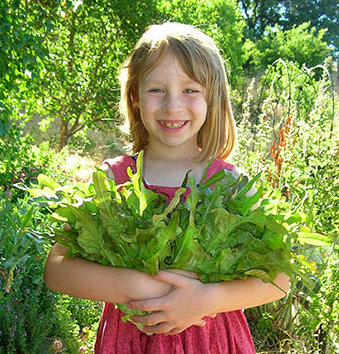 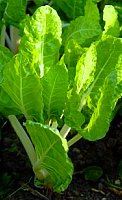  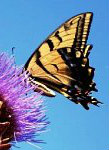
Welcome
to the Bountiful Gardens Spring
Newsletter
For the best view, click on
the option to "view in a browser". It could be at the top or
bottom of your email window.
This newsletter is heavy on
how-to information, rather than products. We have lots of
links, tools, and info on spring planting, why and how to rotate crops,
garden planning, soil prep, and
coping with drought, floods,
cold,
and generally weird weather.
One little note: Lentils
somehow got left out of the catalog. We still carry them! click here for lentils.
And our Rainbow
Carrot Mix is missing from the catalog Carrot section. Here's the link:
Carrot Mix
Let's Get Some Food on the Table: Crops to Plant
Outdoors First
These are the crops you can plant first:
Spinach, Peas, Lettuce, Radish
Mizuna and Tatsoi (mild Asian
Greens--often used in salad mix)
Chervil (a fresh herb for
salads and cooking)You can plant the above seeds or plants
outdoors if the soil temperature is above 45. Generally that's when
ground itself is no longer frozen, and is well-drained enough to crumble
when handled (light frosts are OK). Trees are usually breaking dormancy
at that time, with their buds swelling and just starting to get tiny
leaves. These crops can go in about 2 weeks
later, when soil temps are around 50:
Beets, Broccoli, Cabbage, Carrots, Lettuce, Turnips, Pak Choi, ChardEven if you don't have a place indoors to start
seedlings, it can be helpful to start the seeds in flats or pots at
first. That way, you don't have to wait until you get the whole
vegetable bed prepared--all you need are flats or pots and some potting
mix (or soil and compost.) You can prepare the bed while the
little seedlings are growing. You can control the
spacing of your plants when you transplant them, instead of
sowing lots of seed too thickly, and having to thin them later--which is
time-consuming, fiddly work, besides wasting seed. You can put the flats
where they can get the most sun. And you can
keep them safe from cats, birds, slugs, wind, and other
hazards of the open garden just by slipping chicken wire, clear plastic
or other cover over them. Sow seeds in loose, well-drained soil
that has had compost worked in. Plant each seed twice as deep
as the seed is wide. For fastest
growth, and resistance to disease and drought, we like to use fungal inoculants at
planting time.A
good habit is to sow only part of your seed at first, saving the
rest to plant a week or two later.That way, if the seeds come to harm,
you still have some. And when harvest time comes, you won't have all
your produce at once, but can pick over a long period. This is what
books and catalogs mean by "succession-sowing."
Click here to see seeds to plant
now for spring.Click here for fungal
inoculants.For simple
directions on how to start seeds, please see the bottom of this
page.
Aaargh! too many choices?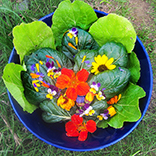
Don't have time to
agonize over what to plant? These collections are a solution:
Spring Salad Collection-
Colorful assorted salad that grow fast in cool weather.
Easy Heirloom Collection-Ten packets
of heirloom vegetables everyone loves
Edible Flower
Collection-Shown at right. Five beautiful, edible flowers.
Info sheet has projects, recipes.
Salsa Collection-Seeds for the
ingredients, and recipes on the info sheet.
We have lots of
pre-chosen theme collections, including beneficial insect attractors and
both medicinal and culinary herbs. Some come with a book to get you (or
the person you are gifting) started on a new kind of garden. To see them all, click
here.
Preparing the Soil: a Step that
Can Make or Break your Garden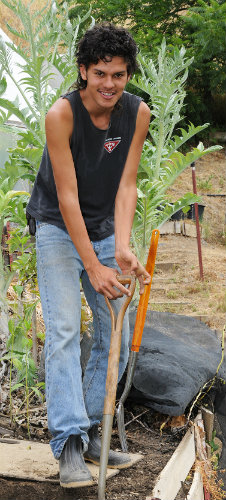 We'll keep it short--good soil preparation gives
you a better garden, and can make all the difference. Here are the
things we like best for getting ready: We'll keep it short--good soil preparation gives
you a better garden, and can make all the difference. Here are the
things we like best for getting ready:
Forged forks and spades are
lifetime tools that we use constantly. We especially love the
fork--easier to lift and dig with than a shovel.
Forged hand tools--We just found
these a short time ago. We love them for weeding and cultivating in the
beds all summer. the cuttlefish hoe is for digging out deep-rooted weeds
or breaking up the soil to plant. the Gama
The how-to book that started
the biointensive garden revolution--full directions and charts on how to
feed and take care of your soil so it feeds you.
Click here for How to grow More Vegetables
by John Jeavons
Luscious
Crops of Summer: Start These Now for Summer
HarvestHot-weather
crops like tomatoes need lots of time in a warm place before planting
out. Many gardeners
sow tomato seeds, along with peppers, onions, and eggplants in Feb-Marchfor planting
outside in May or June.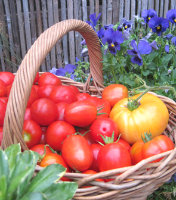
Garden crops need much brighter light than
houseplants. Plants
that are tall and thin, with lots of stem between leaves, need more
light. A sunny window will work,
if all the seedlings can get light--you
may have to turn the flat often. If the window "almost
works," consider hanging a light just over the plants. A compact
florescent (larger size) in a cheap plug-in "droplight" could be just
the boost they need. If it is placed to the on the opposite side of the
flats from the window, it can balance the light, so they don't grow at a
slant.
Many gardeners will need to use mostly
artificial light. A florescent "shop light" or "grow
light" fixture is not very expensive, uses little power, and works well
as long as it is close to the plants--light loses strength quickly with
distance. Hang your light on adjustable chain or cord so that it
can start 4-6" from the soil, and raise it as the plants grow (or, start
by putting the plants on blocks and lower them.) If a plant
gets bleached leaves, the light is too close.
Click here
for seeds to start now for
summer
Click here for a booklet on growing extra-early
tomatoes using no added heat
What Goes Where/When/How/Why?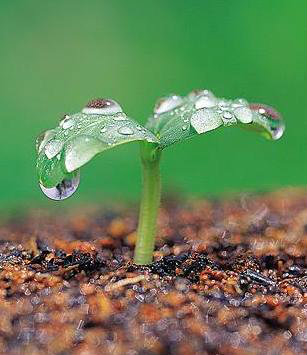 Figuring out what
to put where, and when to do it, can be a puzzle. Here are some
sources for help: Figuring out what
to put where, and when to do it, can be a puzzle. Here are some
sources for help:
Where are
you? The way to know when to
plant is your last frost date. To find out, check with a local garden
center, your Cooperative Extension Service, County Ag Dept, Public
Library, or check the map here: http://www.weather.com/maps/activity/garden/usnationalnormallastfreeze_large.htmlWhen/how to plant: our
Garden Planning Poster has
planting times, spacing, possible companions,soil temps, fertility
needs, and advice. Dark green print on a cream background,
3'x2'.
What uses less
water? If you want to plan for
lower water needs, we have sources for you:
Free tips on how to cope. See the bottom
of the page.
We stock several books that are detailed and helpful, at
the bottom of this page also.
We
have a new page on our website that is all drought-tolerant
crops. Drought-tolerant
crops.
Planning for saving seed:
You will need to know which crops cross with each other
and how far they need to be separated from other varieties. We recommend
Seed to Seed by Suzanne
Ashworth, the best reference for organic vegetable
gardeners. For less detail about more crops: Saving Seed by Marc
Rogers
Rotate Plant
Families: There are lots of ways to rotate crops, based
on when they start and finish, their fertility requirements, and so on.
But here's the bottom line: Garden crops
have families, and many pests target only one family.
If they are
planted in the same place over and over, they get more diseases and
pests, so move them as a group. The
plant families are:
Pea
family--peas, beans, clover, vetch, favas, lentils. These build the soil by pulling nitrogen out of
the air.
Cabbage
family--cabbage, kale, cauliflower, broccoli, mustards, Asian
greens. These need lots of
compost.
Potato (nightshade)
family--tomatoes, peppers, potatoes, tobacco, nicotiana
flowers.Try to keep foliage
dry
Carrot
family--parsley, carrot, parsnip, celery, cilantro, dill.
Scatter these around the garden to control
pests.
Spinach (goosefoot)
family--spinach, chard, beets, quinoa, beetberry, magentaspreen,
Good King Henry.
Cucumber
family--squash, cucumbers,
melons. Mix in some some strong-smelling
herbs to deter squash-family pests.
Daisy family--lettuce, endive, chickory,
sunflowers, cardoon, salsify. These can be
mixed in among the others.
Luscious
Crops of Summer: These Get Started a Bit Later
 Squash, melons, basil, okra and cucumbers can
be sown a month before planting out, or direct in the garden once soil
is warm. Beans and corn can
be sown 2 weeks before planting out, or direct in the garden. All of
these crops need warm soil and can't stand any frost. They grow faster
than tomatoes or peppers do, love heat, and only need a short time in
the pot. Squash, beans, and flour corn store easily for winter,
too. Squash, melons, basil, okra and cucumbers can
be sown a month before planting out, or direct in the garden once soil
is warm. Beans and corn can
be sown 2 weeks before planting out, or direct in the garden. All of
these crops need warm soil and can't stand any frost. They grow faster
than tomatoes or peppers do, love heat, and only need a short time in
the pot. Squash, beans, and flour corn store easily for winter,
too.
Water: Lifeblood of your
Garden
Now is the time to plan for a
low-water-use garden. Even in the desert, folks like Brad Lancaster have
turned their homes into oases without using any water but the rain (10"
at his house) that falls on site. Often you can trap enough water
just in the soil itself. Photos and instructions for
inspiring, low-cost solutions.
Click here to see Rainwater Harvesting by
Brad Lancaster
Gary Paul Nabhan is often called "The
father of the local foods movement" He has worked for decades to
discover and preserve the varieties and techniques that allowed Native
peoples to grow food in areas considered too dry for agriculture. This,
his new book, goes around the world and then into your back yard to show
how you can grow food in a time of increasing heat and drought.
Inspiring!
Click here for Growing Food in a Hotter,
Drier, Land
Drought isn't the only weird weather
going on. Floods, storms, and all manner of havoc are on the increase.
The Weather-Resilient Garden goes through all the different climate
extremes that can affect your garden and tells how to avoid, minimize,
repair and recover. Concentrates primarily on more permanent plantings,
which are harder to replace, like trees and shrubbery, and not
necessarily organic. More focussed on the East than the West--cfor
example, covers what to do about increasing levels of humidity than are
bringing more plant diseases to some areas.
Click here for the Weather-Resilient
Garden
Our own Ecology Action also has a pamphlet
covering strategies for low water use, including different ways of
diging and planning your beds to trap all water that falls on them.
Charts and table compare yields, water needs, and requirements of
various crops. text explains various strategies in use in Africa, the
Southwest, and elsewhere.
Click here for Growing More food with
less water.
Gardening tips for drought
areas:
- All vegetables need more water than drought-adapted plants like
herbs and desert natives. However, some have lower water needs than
others. We have put a new section on our website for these. To see drought-tolerant vegtables,
grains, and other crops, click here.
- Use a fungal
inoculant. This creates an underground
network that actually
extends the roots by up to 300%. Soluable inoculant can be disolved in
water and used to water existing plants, so you aren't limited to just
using it at planting time
- Mulch prevents water loss, cools
the soil, and increases biological activity in the top layers of soil.
You can use plant-based mulch, like straw or even dead weeds (avoid
bark, which is full of strong acids). Or, we have had good results with a
mulch of stones, from golf-ball
to fist size or larger.
They allow dew to condense at night and trickle down to
the roots.
- Water in the
evening just before dusk, so it goes into the soil
instead of evaporating. Water the soil, not the plants. If
you are using sprinklers, you will save a lot by switching
to hand watering,or drip irrigation.
- Use shadecloth. Plants will use less water,
the soil will be cooler, and there will be much less stress on plants.
Shade cloth is light, so you can just drive a stick in each corner of
the bed, tilting outward a bit, and drape the cloth on
it. Shadecloth helps
with heat-related problems like sunscald, poor
pollination, and blossom drop.
- We have excellent books on capturing
rainwater, setting up greywater systems, and
other water-saving projects. But today, with no expense, you
can do this: set a bucket near
each sink in the house. When you are running water to get it cool (or
hot), run it into a bowl in the sink and dump it in the bucket. Same
with rinsing dishes, brushing teeth, etc. Many folks will find
that, without using
actual graywater (like bathwater), there's enough clean, unused water
for a whole bed by the end of the day.
- Make a
windbreak. A fence, branches stuck in the ground, a
sheet or tarp, even cardboard boxes to the windward side of a plant
will keep moisture from being lost to the breeze.
- It is
better to have a few plants producing food than lots of plants
barely alive. If plants are wilted or not
growing, try taking out every other
plant, (giving them twice the root zone) and see if they can then make
do with the water available. If that doesn't work, or if the
plants are already very stressed, choose small areas (with plants
in the best shape) to water thoroughly, letting the rest of the garden
go dry. Use dead plants as mulch. Don't wait until all your plants are
too stressed to produce--one plant pumping out food is better than ten
that are just hanging on.
We
almost forgot to tell you that now is the time to plant wildflowers,
like these California Poppies.
For
Wildflower mixes, click here.Whew! That is a lot of information, so maybe
you'll want to save it somewhere for 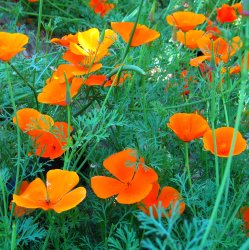 future reference.
We also have information archived here.We are
also on facebook. Here is our Facebook pageSoon we
will all be out in the garden again--and we wish you the very best for
this gardening
season future reference.
We also have information archived here.We are
also on facebook. Here is our Facebook pageSoon we
will all be out in the garden again--and we wish you the very best for
this gardening
season |
Bountiful Gardens
18001 Shafer
Ranch Rd
Willits, California 95490
US
|
 | 
_______________________________________________
Livingontheland
mailing
list
Livingontheland@lists.ibiblio.org
http://lists.ibiblio.org/mailman/listinfo/livingontheland

|
This email is free from viruses and malware because avast! Antivirus protection is active.
|
|













